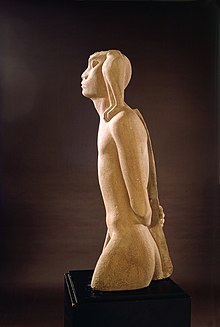Canaanism

Canaanism was a counter-movement against Zionism , Judaism and Israelism among intellectuals in Palestine during the British Mandate and in the State of Israel . Avraham Shlonsky coined the term “Canaanites” as a criticism of the “Young Hebrews” group, but it soon became a self-designation. The poet Yonatan Ratosh founded the "Canaanite Movement". The members were always only a small circle of intellectuals; In the 1940s, however, Canaanism expressed the attitude towards life of many young people in the Yishuv . Canaanism broke with Diaspora Judaism as a social group, with Judaism as a religion and with Judaism as a culture. While secular Zionism and Canaanism were one and the same from the perspective of Orthodox Judaism, the mainstream of secular Zionism distanced itself from Canaanism and branded it as a harmful heresy.
“What was the basic idea of Canaanism? The most important element was a nativist understanding of the Israeli nation ... It wasn't collective memory , cultural heritage, ethnicity or biology that created a nation, but physical space and language blurred differences and acted as a national melting pot. "
Yaakov Shavit explains that the movement was about a construction of history that supported the political claims and visions of the Hebrews in the 20th century. The reference point was the ancient Canaanite culture, as it had become known through the excavations in Ras Shamra ( Ugarit ). The bearers of this Canaanite civilization were therefore Israelites , Phoenicians , Canaanites , Edomites , Moabites and Amorites ; the language of this ancient cultural area was Hebrew . Because the Phoenicians were assigned to the Canaanite civilization, a counter-model to the Greek and Roman antiquity was available here (Carthage as the antagonist of Rome).
Ron Kuzar sees the roots of Canaanism in the European right-wing extremist political spectrum, especially Italian fascism . The attitude towards the Arab population was ambivalent: militarism and power politics towards Arab society, but an inviting openness towards Arabs as individuals. The political agenda of Canaanism considered a future war to be the only way to transform the states and societies of the Fertile Crescent into a "Hebrew" cultural area. Neither a Jewish nor an Arab state should arise there, but an association of states with a common culture and the common Hebrew language. The historical task of the yishuv is to initiate these changes.
literature
- Daniel Krohabennik : New panels. Nietzsche and the Jewish Counter-History . In: Werner Stegmaier , Daniel Krohabennik: Jüdischer Nietzscheanismus (= monographs and texts on Nietzsche research . Volume 36). Walter de Gruyter, Berlin / New York 1997, pp. 53–81.
- David Ohana: The Origins of Israelite Mythology: Neither Canaanites nor Crusaders . Cambridge University Press, New York 2012.
- Yaakov Shavit: The New Hebrew Nation: A Study in Israeli Heresy and Fantasy . Frank Cass, London 1987.
Individual evidence
- ^ David Ohana, The Origins of Israelite Mythology: Neither Canaanites nor Crusaders , New York 2012, pp. 13-16.
- ^ Yaakov Shavit: The New Hebrew Nation: A Study in Israeli Heresy and Fantasy , London 1987, p. 3.
- ↑ David Ohana: The Origins of Israelite Mythology: Neither Canaanites nor Crusaders , New York 2012, p. 17.
- ↑ Daniel Krohabennik: New panels. Nietzsche and the Jewish Counter-History , Berlin / New York 1997, p. 72 f.
- ↑ Ron Kuzar: Hebrew and Zionism: A Discourse Analytic Cultural Study . Walter de Gruyter, Berlin / New York 2001, p. 12 f.
- ↑ So-called land of Kedem, in Hebrew קדם ḳedem "East."
- ^ Yaakov Shavit: The New Hebrew Nation: A Study in Israeli Heresy and Fantasy , London 1987, p. 6.